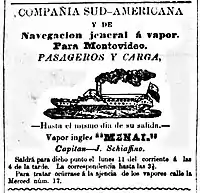Vapor Menay
Vapor Menay was a British steamer belonging to the South American and General Steam Navigation Company.[1] It covered the Buenos Aires - Liverpool route, with stops in the ports of Montevideo and Rio de Janeiro.[2] It was acquired by the government of the Argentine Confederation in 1859, being equipped as a warship with the name of Coronel Dorrego. It was used during the Argentine Civil War and the War of the Triple Alliance, where it served in logistics tasks under the name of Vapor Chacabuco.[3]
 advertising referring to Menay | |
| History | |
|---|---|
1851-1859 1859-1861 since - 1861 | |
| Builder: | Dumbarton shipyards, Scotland |
| Launched: | 1851 |
| Acquired: | South American and General Steam Navigation Company |
| Commissioned: | 1853 |
| Decommissioned: | 1859 |
| In service: | 1853-1868 |
| Status: | Steam of passengers (1853-1859) |
| Notes: | War Ship (1859-1868) |
| General characteristics | |
| Class and type: | steamboat |
| Displacement: | 185 tons |
| Length: | 92 ft (28 m) |
| Beam: | 18 ft (5, 75 m) |
| Draft: | 6,5 ft (1,95 m) |
| Propulsion: | steam engine |
| Speed: | 7.5 knots |
| Complement: | up to 60 men maximum |
| Armament: | two cannons |
History
It was built in 1851 in the shipyards of Dumbarton, Scotland,[4] and acquired in 1853 by the South American and General Steam Navigation Company, to make trips between Buenos Aires and Montevideo.[5] This company also owned the vapors Pampero and La Plata, modern boats that together with the Menay made continuous trips to the British Isles.[6]
His agent in Buenos Aires was Henry Dowse, who had his offices at No. 17 Calle de la Merced (now Perón), Barrio de San Nicolás.[7]
In 1859 the Menay was bought by the government of the Argentine Confederation, which ordered to equip it with two cannons. Several Argentine leaders were transported on this steamer, including President Santiago Derqui on his visit to General Justo José de Urquiza, prior to the Battle of Pavón.[8] Domingo Faustino Sarmiento traveled aboard the Menay to Rio de Janeiro accompanied among others by Lucio Mansilla.[9]
In 1862 it was acquired by the Compañía Salteña de Navegación a Vapor, who once again used the name Menay.[10] Years later it was expropriated by the Argentine government, which once again changed its original name to Chacabuco.[11]
Among his captains were Julio Fonrouge, who took part in the Battle of Martín García occurred during the civil war,[12] and José María Manzano, in charge of transporting an English Rifle Company to Itapirú, to be incorporated into the Paraguayan War.[13]
Gallery
 passenger list in 1859, includes several members of the National Party
passenger list in 1859, includes several members of the National Party advertisement of Compañia Sudamericana de Navegacion a Vapor
advertisement of Compañia Sudamericana de Navegacion a Vapor sailings of the port of Buenos Aires on May, 1855
sailings of the port of Buenos Aires on May, 1855
References
- Planos, vistas y cartas geograficas: Catálogo de la sección XVI. Museo Mitre. 1918.
- South American Packets: The British Packet Service to Brazil, the River Plate, the West Coast (via the Straits of Magellan), and the Falkland Islands, 1808-80. Jeremy N. T. Howat. 1984.
- Apuntes sobre los buques de guerra de la armada argentina, 1810-1970, Volumen 6. Comando en Jefe de la Armada, Secretaría General Naval, Departamento de Estudios Históricos Navales. 1972.
- Marwood's North of England Maritime Directory, Shipping Register and. Thomas Marwood. 1855.
- Brazil, the River Plate, and the Falkland Islands: With the Cape Horn Route ... William Hadfield. 1854.
- Repúblicas americanas: Episodios de la vida privada, política y social en la. Ildefonso Antonio Bermejo. 1873.
- Mensajerías argentinas. Carlos Jewell. 1966.
- Vida de un héroe: biografía del brigadier general Juan Esteban Pedernera. Luis Horacio Velázquez. 1858.
- Sarmiento: la vida, la obra, las ideas, el genio. Alberto Palcos. 1962.
- Revista histórica, Volumen 1,Números 1-3. The Instituto. 1977.
- Archivo del general Mitre, Volúmenes 5-6. Bartolomé Mitre.
- Un siglo de instituciones, Volúmenes 1-2. Buenos Aires (Argentina : Province). Ministerio de Gobierno. 1910.
- Apuntes sobre los buques de guerra de la armada argentina, 1810-1970, Volumen 3. Pablo E. Arguindeguy. 1972.